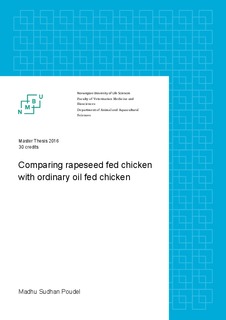| dc.description.abstract | Energy is needed for the poultry in order to provide growth, egg production at a high level to
allow maximal economic return for the production unit. In diet formulation, fat is added to
increase palatability, increase fat soluble vitamin and to control dust in feed mill industry
Soybean oil consists of high proportion of unsaturated fatty acid which is well utilized by
poultry in order to meet energy requirement for fast growing broilers. The use of rapeseed oil
is popular all over the world due to improvement made on it. A rapeseed line which contains
the low amount of erucic acid and good balance between n-3 and n-6 fatty acids has been
made. The aim of the present study was to compare fatty acid profile of breast muscle in
chickens fed a diet containing rapeseed oil with ordinary soybean oil feed. In the present
study, 36 chickens were included and 18 of the chicken received the diet containing rapeseed
oil (diet 1) and 18 chickens received the diet containing soybean oil (diet 2).
Chickens fed with soybean oil feed had more saturated fatty acids like palmitic acid and
stearic acid in muscle compared to chickens fed rapeseed oil feed. Oleic acid was significantly
different between the two diets and it was less oleic acid in soybean oil than rapeseed oil.
Comparing soybean oil with rapeseed oil, soybean oil contains more linoleic acid than
rapeseed oil. Linoleic acid is converted to arachidonic acid in chicken through desaturation
and elongation process. EPA, DPA and DHA, n-3 derivatives of α-linolenic acid are
synthesized in chickens in the process similar to arachidonic acid by desaturation and
elongation. That is why high amounts of fatty acids in the feed are now converted in same
pattern in muscle. There is significant (p <0.05) lower amount of arachidonic acid and higher
amounts of the long chain fatty acids EPA, DPA and DHA in the chicken breast muscle of
chicken fed diet containing rapeseed oil compared to soybean oil.
Our results show the final body weight was not different between the two diet groups.
Consumption of meat from chickens fed the rapeseed oil containing feed can help us to
increase the total intake of n-3 LCPUFA and reduce arachidonic acid without the consumer
having to change their eating habits. | nb_NO |
